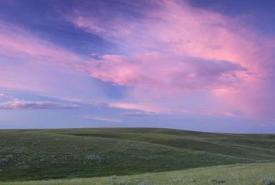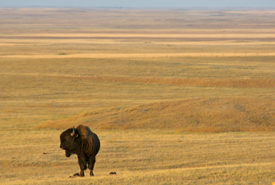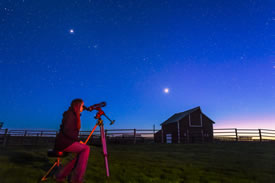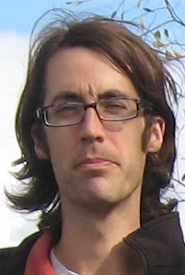Adapting to realities: From conservation science to sleeping outdoors

Evening sky at Old Man on His Back Ranch, SK (Photo by Branimir Gjetvaj)
I was about a half hour out of Saskatoon when I realized I had forgotten to pack my tent. It was the middle of September and I was planning on camping at the Nature Conservancy of Canada’s (NCC’s) Old Man on His Back Prairie and Heritage Conservation Area (OMB) in southwest Saskatchewan. It was the night before NCC’s Cypress Uplands Natural Area Conservation Plan (NACP) workshop — an important part of our conservation process that helps us decide what steps to take in the coming years.
We’ve done a few of these planning workshops where we develop a conservation plan, referred to as a Natural Areas Conservation Plan (NACP), for the different areas of Saskatchewan in which we work. Besides being fun and great learning experiences, NACPs become lessons in adaptation; they are how we identify, plan and execute the protection of the best of Canada’s natural spaces and manage and restore them for the long term. The process ensures our conservation actions (like buying land, controlling invasive weeds or mapping the location of rare species) are efficient and effective, and they determine how we will take action and measure our success for the next 10 years.
I wanted to camp, not so much because I wanted to save NCC the couple of bucks for a hotel room in Pulitzer Prize for Fiction 1972 winner and prairie poster boy Wallace Stegner’s hometown of Eastend, but because the rest of the staff was spending the night at the OMB interpretative centre doing monitoring in the area and I wanted to hang out with them (though not so much that I wanted to sleep on the floor of the interpretive centre, but all the beds in the centre were taken by the early-to-bed folks).

Buffalo, Old Man on his Back Ranch, Saskatchewan (Photo by NCC)
So, I planned to camp on the floor of the interpretive centre, but packed to fail or failed to pack. I had my bag, all my clothes and my sleeping mat. I was, however, missing the thin sheet of nylon held up by flexible poles. It was looking like I might have to use a couple of sleeping mats with maybe a bison hide for extra comfort.
And then it hit me. It was eerily calm outside, with only the slightest breeze. Unlike my last restless overnight stay at OMB, there wasn’t even enough wind to tease loose the bangy parts of the threshing machine left on the Butalas' yard site from well before their time. Also, there were no mosquitoes, as several nights of frost had taken care of that. And really, if I couldn’t handle a couple of degrees below zero, how was I going to manage leading a discussion on biodiversity targets, threats and potential activities with ranchers and tourism people, retired entomologists and water techs coming out for the next day’s talk?
I’m pretty sure that’s not in reality how I talked myself into flinging my sleeping mats, sleeping bag, pillow and every piece of clothing I brought on to the tall crested wheatgrass at the back end of the yard. It was nothing that noble. Really, I just wanted the bragging rights. “Oh, really? The floor was a little hard? Well, let me tell you about my bed of crested wheatgrass and the starry, starry night.” It was super-soft, actually, but I had to wrap my jacket around my head for warmth to keep from fleeing back to the interpretive centre.

Old Man on His Back, SK, has just been named Canada's second Dark Sky Preserve (Photo by Alan Dyer)
Regardless of my self-imposed and ill-prepared sleeping situation, the next day went well. Around 9 a.m. folks started showing up to the sun-soaked entrance of Eastend’s T. Rex Discovery Centre museum, where NCC’s Natalie Hassett, Ryan Dudragne, Emily Little and I greeted people with piles of sticky notes and the strongest coffee I could handle.
People asked really good questions, tolerated my jokes and filled us in on the realities of balancing making a living in the Cypress Uplands with maintaining a home for the plants and animals that have always been there. We split the day up with a presentation from Tim Tokaryk, head paleontologist at the Discovery Centre, who told us about the trials and tribulations of securing fossils from our province’s distant past, followed by Butch Amundson from Stantec in Saskatoon, who regaled us with tales of archeological discoveries that shed light on Saskatchewan’s past ecosystems.
We were lucky to have so many resource managers at the table, wearing multiple hats, to discuss ideas we could incorporate into the area’s management plan. There was specific direction on how to form an invasive species working group for the area, ways to tackle fire suppression by focusing on preventing catastrophic wildfires and a unique perspective on the impact of grazing on species diversity. We are learning, as a group, to adapt our initial plans with what we hear from people during these workshops. This method of plan development and implementation is called open standards and is dependent on a commitment to applying what you know, observing the results of your actions and making changes to the original plan — in other words, adapting to the realities.
Speaking of which, next time I’m bringing a tent. Or better yet, staying at a B&B.


